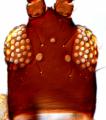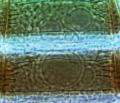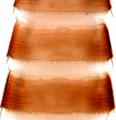Bregmatothrips venustus
Recognition data
Distinguishing features
Female fully winged, with body brown, but tarsi, apices of tibiae, and antennal segments III–V yellow; forewing pale or very weakly shaded. Head longer than wide, projecting in front of eyes, with 3 pairs of ocelli, pair III anterolateral to ocellar triangle. Antennae 8-segmented, III–IV with sensorium simple. Pronotum with 2 pairs of prominent posteroangular setae. Metanotum with characteristic transverse reticulation, median setae close to anterior margin. Forewing first vein with 2 setae on distal half, second vein with 8 to 9 setae. Tergites I–VIII with median pair of campaniform sensilla close to posterior margin, II–VIII with no sculpture medially, with marginal craspedum of small lobes; tergite IX large, almost 1.5 times as long as VIII. Sternites without discal setae.
Male with wing lobe shorter than thorax width; body brown with pterothorax and abdominal segment I yellow; abdominal tergites with several lines of sculpture medially; sternites without pore plates.
Related and similar species
The genus Bregmatothrips includes nine species (Mound, 2011). The geographical distribution of these is interesting, with eight species from the Old World, and B. venustus widespread but apparently native to the Americas. Stannard (1968) treated what is now considered to be B. venustus as two or three different species. Bhatti (1984) discussed variation between several species, and Mound (2011) provided a preliminary key to the world species.
Taxonomic data
Current valid name
Bregmatothrips venustus Hood
Original name and synonyms
- Bregmatothrips venustus Hood, 1912: 67
- Limocercyothrips bicolor Watson, 1926: 10
- Bregmatothrips gracilis Hood & Williams, 1915: 122
- Bregmatothrips sonorensis Stannard, 1956: 71
- Bregmatothrips difficilis Johansen, 1977: 45
Family placement
Thripidae, Thripinae
Biological data
Life history
Breeding on leaves.
Host plants
Various Poaceae, but with no recorded specificity.
Tospoviruses vectored
None
Crop damage
Possibly associated with leaf damage on Zea mays.
Distribution data
Area of origin
Western USA
Distribution
USA (California, Texas, Arizona, New Mexico, Tennessee, Wyoming, Illinois, Georgia, Hawaii), Mexico, Cuba, Peru, Galapagos Islands [?Africa, see Mound, 2011: 40].










